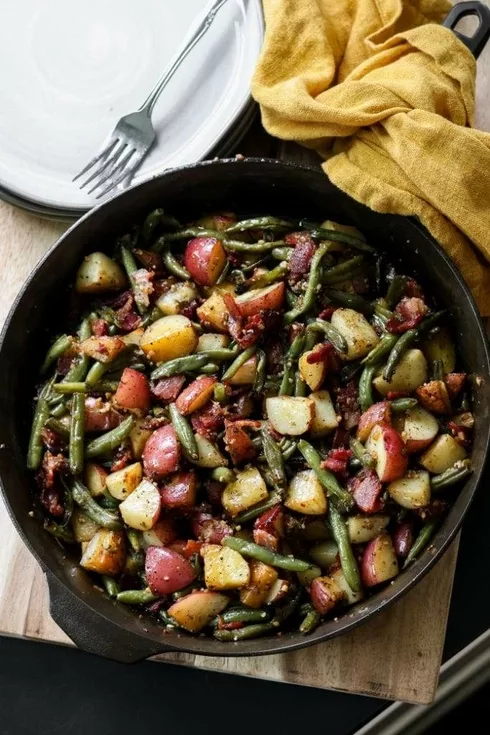Cooking With Cast Iron
Welcome to the ultimate guide to cooking with cast iron skillets. Here you will find everything you need to know about how to get the most out of cast iron cookware.
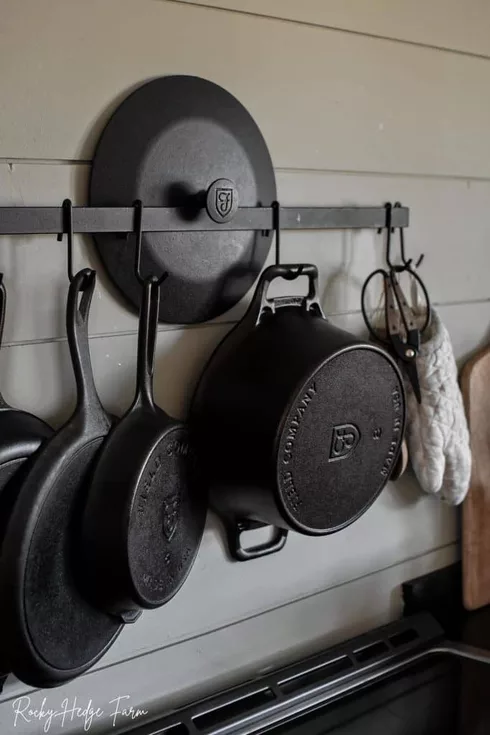
From the best cast iron skillet recipes and tips to the amazing benefits, we will explore how to care for your skillet properly and how to season and heat it to make delicious meals for your family.
With this guide, you will learn how to make the most out of cooking with cast iron and why it is one of the best investments you can make in your kitchen.
Cooking with Cast Iron Skillet
Cast iron is the way to go if you are looking for cookware that can stand the test of time and provide delicious meals every time.
Not only is cast iron incredibly durable and can last for decades, but it is also incredibly versatile. You can use it on the stovetop, grill, oven, and even over an open fire to make cast iron recipes.
Plus, the heat retention of cast iron is second to none, so your food will cook evenly and taste amazing. With a bit of maintenance, you can ensure that your cast-iron cookware will last you for years.
Here are some valuable resources to keep in mind when cooking with cast iron cookware:
- How To Season Cast Iron Pans
- Best Oil for Seasoning Cast Iron
- How To Store Cast Iron Pans
- How To Clean Enameled Cast Iron
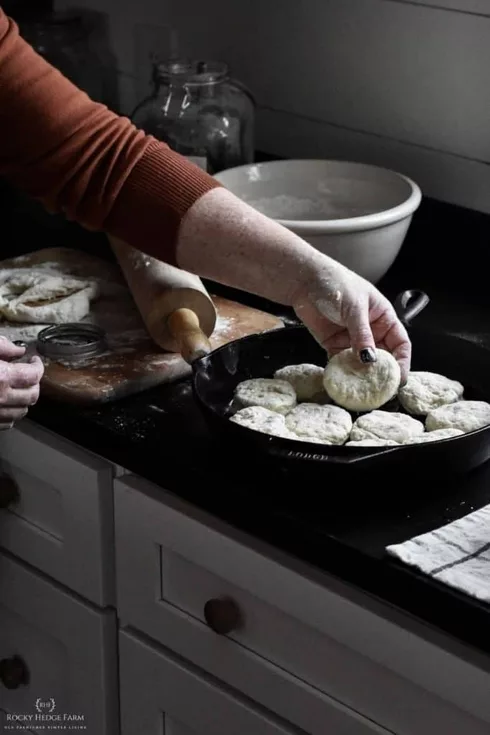
Cooking with Cast Iron Benefits
The cast-iron skillet is a kitchen essential that many people prefer for its durability, heat retention, and even cooking. Cast iron can conduct heat quickly and evenly, which makes it perfect for searing, sauteing, and frying.
In addition, one of the other benefits of cooking with cast iron is that it can handle high temperatures and is great for cooking on the stovetop or in the oven.
Cast iron cookware is easy to clean and maintain, as it only requires occasional seasoning with oil.
Incredibly versatile, cooking eggs with cast iron to fruit crisps, anything can be made in a cast iron skillet.
Health Benefits
Research has shown that cast-iron use does have some impact on the iron level in food. Cooking in a cast iron skillet is a great way to get a bit of extra iron in your diet.
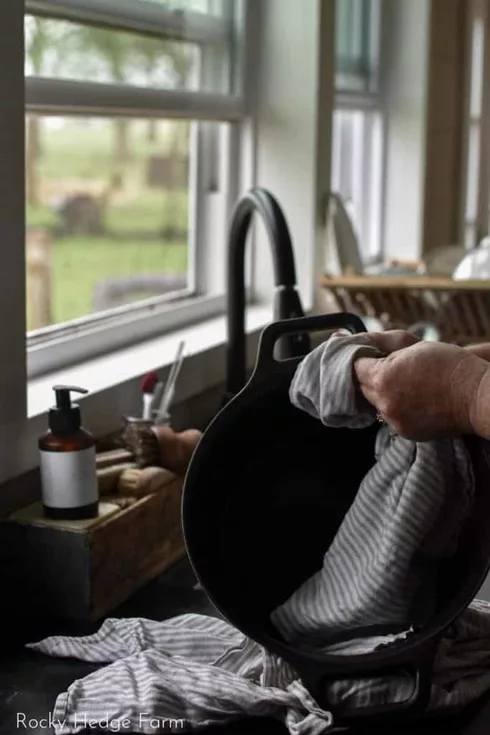
Cooking with Cast Iron Essentials
With a few kitchen essential items, you can start cooking with cast iron cookware and have what you need to clean, maintain and store your skillets and pans.
- Cast Iron Skillets – Field Company makes my favorite cast iron cookware. Made with attention to detail, they offer a smooth, pre-seasoned surface that improves with use, making them ideal for searing, sautéing, baking, and more.
- Tools – If you have created a burnt, sticky mess in your seasoned or enameled cast iron cookware, you will need a few essentials to clean it.
- Skillet Pan Handle Cover – Use a handle cover on a cast iron skillet to protect your hand from the hot metal handle.
- Leather Handle Cover
- Seasoning Oil – organic grapeseed oil and organic linoleic sunflower oil, both high in polyunsaturated fats, are well-suited for seasoning.
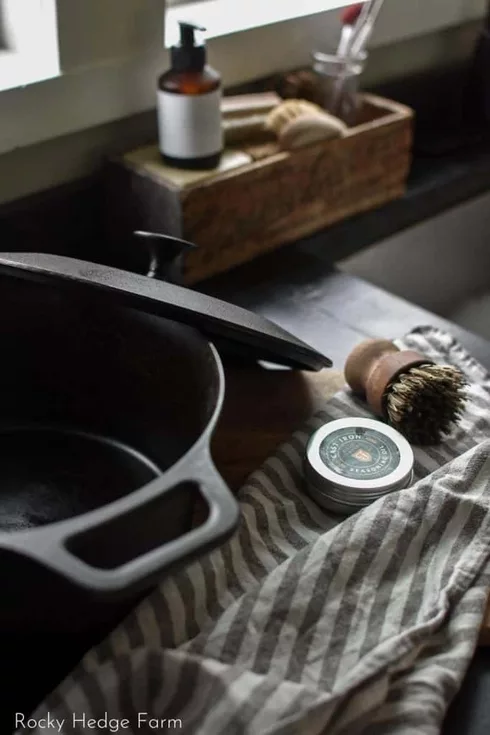
Why You Should Cook With Cast Iron
This old-fashioned cookware is returning in many homes due to its many advantages. So why are cast iron skillets and pans such a kitchen essential?
Here are several good reasons you should cook with cast iron.
Cast Iron is Naturally Non-Stick
A cast iron pan is an excellent choice for cookware due to its ability to develop a coating that prevents most food from sticking.
With proper seasoning and care, the pan will create a natural, non-stick surface much healthier than chemical-laden non-stick finishes.
With a well-seasoned pan, you can always cook fried and scrambled eggs, which will never stick!
Cast Iron Retains Heat
Cast iron retains heat well. After pre-heating, cast iron can maintain a consistent temperature for an extended period. This makes the hot pan perfect for searing and frying!
Cast Iron is Long Lasting
Cast iron cookware is known for its durability, often being passed down through generations. If taken care of properly, you can expect your cast iron cookware to last a lifetime.
Cast Iron is Versatile
Cast iron cookware is incredibly versatile; it can be used on the stovetop, in the oven, on the grill, and even during camping trips. You can also serve food directly in the skillet – making fewer dishes to wash.
Cast Iron is Easy to Clean
You can easily clean a cast-iron pan by wiping it down with a paper towel, a little water, and a cotton dishcloth. The pan’s seasoning will make removing burnt or stuck-on food easier, but if any pieces remain, use a plastic spatula to scrape them off.

Cooking with Cast Iron Techniques
Cooking with cast iron is a technique that has been used for centuries. Cast iron is durable and perfect for cooking over an open flame, stovetop recipes, or dutch oven recipes.
Cast iron skillets are great for searing and grilling food because they can get very hot and retain that heat for a long period. At the same time, cast iron dutch oven recipes are great for slow-cooking like stews and roasts.
Here are several techniques to follow when cooking with cast iron.
Properly Heat a Cast Iron Skillet
Before you begin cooking with your skillet on the stovetop, make sure to preheat it. Putting food into a cold cast-iron pan can lead to the food sticking and make the pan difficult to clean.
To ensure even heating, gradually pre-heat a cast iron skillet on a similar-sized burner. As cast iron retains heat well, using a high heat setting is unnecessary. Most cast iron heats on low to medium heat.
Once your pan is pre-heated, add a little oil or fat. Then add your food.

Seasoning Your Cast Iron Skillet
After a while, your cast iron skillet may not look as shiny and smooth as it once did, and food may stick to the surface. However, restoring the seasoning on your skillet to get a non-stick and glossy surface is simple with a few steps.
However, If you cook with your pan regularly, you likely won’t ever need to go through the seasoning process with your pan.
- Preheat the oven to 450°F.
- Scrub the skillet with a stiff brush and hot soapy water.
- Rinse and dry the skillet thoroughly.
- Apply a thin layer of oil to the inside of the skillet.
- Place the cast iron skillet in the oven and bake for one hour.
- Turn off the oven and allow the skillet to cool in the oven.
- Wipe away any excess oil.

Cleaning a Cast Iron Pan
Cleaning a cast iron skillet is easy with only a few items. You only need hot water, a dishcloth, and maybe a chainmail scrubber or pan scraper to remove the stubborn spots. Remember to clean the handle and the bottom of the pan.

Maintaining Your Cast Iron Skillets
Maintaining a cast iron skillet is essential for developing a nonstick surface that will last over time, making them perfect for cooking everything from meats to vegetables.
- Clean – After each use, it is crucial to thoroughly clean the skillet using warm water and a scrub brush. Cleaning will help remove bits of food particles and prevent food from sticking.
- Dry – Once clean, the most important step is to dry the skillet entirely and apply a thin layer of oil to help keep the pan lubricated.
- Store – Finally, store the skillet in a dry place or hang your cast iron cookware, and resist the temptation to stack pieces of cast iron on each other. With proper care, your cast iron skillet should last you a lifetime.

Tips For Cooking with Cast Iron
Cooking with cast iron can differ slightly from other cookware, but you can get the best results with a few tips and tricks. Here are some tips to keep in mind.
Avoid Sticky Foods
To get the most out of your new skillet, start by cooking foods high in fat, such as bacon. This will help to season the pan and build up the nonstick coating. After several months of use and care, you can cook foods like eggs and pancakes without them sticking.
Avoid Acidic Food
Avoiding acidic food in cast iron is important to maintain it properly. Acidic foods like lemon, juice, tomatoes, tomato sauce, and vinegar can cause the seasoning to break down over time.
If you need to add acidic ingredients to a recipe, use them in moderation or prepare the food in an enameled cast iron skillet.

Hand Wash Cast Iron
Cast iron skillets should never be put into the dishwasher; you should hand wash them. Handwashing allows you to scrub away any food or grease stuck in the pan without harsh chemicals.
Avoid Thermal Shock
When using cast iron, it is important to avoid thermal shock, which is when it is exposed to rapid changes in temperature.
For instance, avoid immersing the pan in cold water straight from the stove. This could result in the pan cracking.
Don’t Store Food in Your Skillet
When using a cast iron skillet, it is important not to leave food in it for an extended period of time. The food should be removed from the pan, and leftovers stored in a separate container.
Keeping the pan dry and avoiding prolonged contact between food and the pan is important for preserving the seasoning.
Use an Oven Mitt
To protect yourself from burns, a mitt or a handle cover is essential when dealing with cast iron pans. The handles are not heatproof and could cause burns when picking them up.
Dry Your Skillet
Thoroughly dry your cast iron after washing to prevent rust. You can use a dish towel to absorb excess water or heat it on the stovetop until all the moisture evaporates. Hanging the cast iron is the best way to avoid moisture getting trapped in the skillet.

Cast Iron Recipes
Cooking with a cast iron skillet can bring out the best in various dishes, from sweet to savory. Here are some recipe ideas for cast iron skillet recipes.
- Breakfast: a cast iron skillet can make frittatas, omelets, and pancakes. The even heat distribution and non-stick surface make it easy to flip and cook eggs without sticking or breaking.
- Main Dish: cast iron skillets are great for searing meats, as they can handle high heat and create a delicious crust. Steak, chicken, and fish benefit from being cooked in a cast iron skillet. Another great option is to roast a whole chicken or pork tenderloin in the skillet. Prepare a one skillet meal such as Creamy Tortellini With Italian Sausage, Old Fashioned Shepherd’s Pie, or Cast Iron Skillet Pork Chops With Creamy Sauce
- Side Dish: the versatility of a cast iron skillet can be used to make various side dishes. Fried potatoes or creamy mac and cheese are classic choices, while cornbread or baked cowboy beans are excellent. Vegetables like asparagus or sweet potatoes are also delicious when cooked in a cast iron skillet.
- Desserts: desserts cooked in a cast iron skillet are always a crowd-pleaser. Skillet cookies, brownies, and fruit crisps are all easy and delicious! Other classic recipes are a peach crisp or a gooey chocolate skillet cake.
In Conclusion
Cooking with cast iron is a great way to get delicious, flavorful dishes with the added benefit of durable and long-lasting cookware.
With proper maintenance and care, a well-seasoned cast iron pan or dutch oven can last a lifetime and be passed down through generations. Cast iron is a great choice for all your cooking needs.



